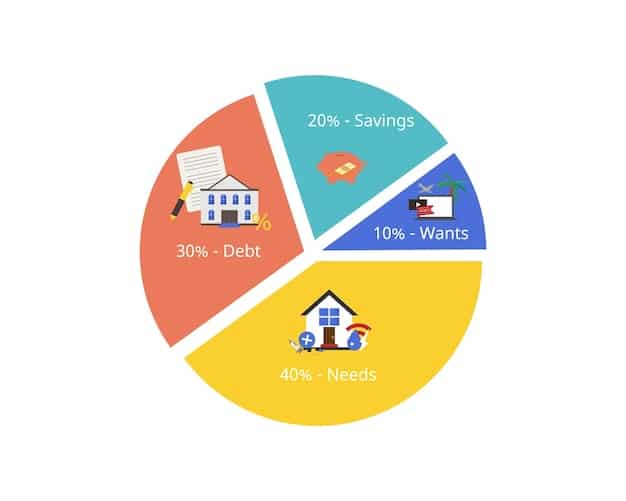REIT Diversification: Shielding Your Portfolio from a 10% Market Correction

REIT diversification is crucial for mitigating risk and ensuring your portfolio is prepared for market volatility, such as a potential 10% correction, by spreading investments across various real estate sectors and geographic locations.
Is your REIT portfolio prepared to weather a potential 10% market correction? Strategic REIT diversification can be your shield, minimizing risk and maximizing long-term returns. Let’s explore how to fortify your investments.
Understanding REIT Diversification and Its Importance
Real Estate Investment Trusts (REITs) have become a popular investment vehicle, offering investors exposure to the real estate market without directly owning properties. However, like any investment, REITs are subject to market fluctuations. Understanding the importance of diversification is key to protecting your investments during periods of market correction.
What are REITs?
REITs are companies that own or finance income-producing real estate across a range of property sectors. They allow individuals to invest in real estate portfolios that may include office buildings, warehouses, shopping malls, apartments, hotels, and more. The beauty of REITs is that they provide regular income streams through dividends, derived from the rental income of the properties they own.
Why is Diversification Important?
Diversification is a risk management strategy that involves spreading your investments across different asset classes, sectors, and geographic regions. When it comes to REITs, diversification can help mitigate the impact of market volatility and economic downturns. By diversifying your REIT portfolio, you reduce the risk of overexposure to a single property type or geographic area.

- Reduces Volatility: Diversification helps smooth out the ups and downs in your portfolio’s value.
- Minimizes Risk: Spreading investments reduces the potential for significant losses from a single underperforming asset.
- Maximizes Returns: Diversification allows you to capture growth opportunities across different sectors and regions.
In conclusion, REITs offer a valuable way to invest in real estate, but diversification is crucial for managing risk and maximizing returns. By understanding the benefits of diversification and implementing a well-diversified REIT portfolio, investors can better prepare for potential market corrections and achieve their long-term financial goals.
Assessing Your Current REIT Portfolio
Before diving into strategies for diversifying your REIT portfolio, it’s essential to assess your current holdings. Understanding your portfolio’s strengths and weaknesses will help you identify areas where diversification is needed.
Analyzing Sector Allocation
Start by examining the sector allocation of your REIT portfolio. Are you heavily invested in one particular sector, such as retail or office spaces? If so, consider diversifying into other sectors like healthcare, industrial, or residential REITs. Each sector has its own unique drivers and sensitivities to economic conditions.
Evaluating Geographic Exposure
Next, evaluate your geographic exposure. Are your REITs concentrated in a specific region or city? Diversifying geographically can help protect your portfolio from local economic downturns or natural disasters that could impact property values and rental income.

- Review Holdings: List all REITs in your portfolio and their respective sectors and locations.
- Identify Concentrations: Determine if there are any significant concentrations in specific sectors or regions.
- Assess Risk Tolerance: Consider your risk tolerance and investment goals to determine the appropriate level of diversification.
In summary, assessing your current REIT portfolio involves analyzing sector allocation and geographic exposure to identify areas where diversification is needed. By understanding your portfolio’s strengths and weaknesses, you can make informed decisions about how to better prepare for potential market corrections and achieve your long-term financial goals.
Strategies for Effective REIT Diversification
Once you have assessed your current REIT portfolio, you can begin implementing strategies for effective diversification. This involves spreading your investments across different property types and geographic regions to mitigate risk and enhance returns.
Diversifying by Property Type
One of the primary ways to diversify your REIT portfolio is by investing in different property types. Each type of property has its own unique characteristics and responds differently to economic conditions. Consider diversifying into sectors such as:
Diversifying by Geographic Region
Another important aspect of REIT diversification is geographic diversification. Investing in REITs that own properties in different geographic regions can help protect your portfolio from local economic downturns or natural disasters. Explore REITs that operate across different states or even countries.
- Invest in Multiple Sectors: Allocate capital to various property types such as residential, commercial, industrial, and healthcare REITs.
- Explore Diverse Locations: Seek REITs with properties in different geographic regions to reduce exposure to local economic factors.
- Consider International REITs: Expand your portfolio by including REITs that invest in real estate markets outside the United States.
In conclusion, effective REIT diversification involves spreading your investments across different property types and geographic regions to mitigate risk and enhance returns. By implementing these strategies, you can better prepare your portfolio for potential market corrections and achieve your long-term financial goals.
REITs and Interest Rate Sensitivity
REITs, like other investments, are influenced by macroeconomic factors, with interest rates being a significant one. Understanding the relationship between REITs and interest rates is crucial for managing your portfolio effectively, especially when anticipating market corrections.
The Impact of Rising Interest Rates
Rising interest rates can impact REITs in several ways. Firstly, higher rates increase the cost of borrowing for REITs, which can reduce their profitability and ability to acquire new properties. Secondly, rising rates can make other fixed-income investments, such as bonds, more attractive, potentially leading investors to shift capital away from REITs.
Strategies to Mitigate Interest Rate Risk
Despite the potential challenges posed by rising interest rates, there are strategies that REIT investors can employ to mitigate risk. These include:
- Floating Rate Debt: Consider REITs that have a significant portion of their debt in floating rates. As interest rates increase, so will the return on investment
- Inflation Hedges: Invest in real estate that will have inflation protection, like hotels. Hotels will likely see their rates increase.
- Lower Debt: REITs with less debt are more likely to weather economic storms.
In summary, understanding the relationship between REITs and interest rates is crucial for managing your portfolio effectively. By recognizing the potential impact of rising interest rates and implementing strategies to mitigate risk, you can better prepare your portfolio for market corrections and achieve your long-term financial goals.
Analyzing the Impact of Economic Indicators on REITs
Economic indicators play a vital role in shaping the performance of REITs. These indicators provide insights into the overall health of the economy and can help investors make informed decisions about their REIT investments. Key economic indicators include gross domestic product (GDP) growth, employment rates, inflation, and consumer confidence.
GDP Growth and REITs
GDP growth is a measure of the total value of goods and services produced in an economy. A strong GDP growth typically leads to increased demand for commercial real estate, such as office spaces and retail properties, which can benefit REITs that own these types of assets. Conversely, a slowdown in GDP growth can lead to decreased demand and lower rental income for REITs.
Employment Rates and REITs
Employment rates are another important indicator to watch. High employment rates generally translate to increased demand for residential properties, benefiting residential REITs. Additionally, higher employment can also boost consumer spending, which can positively impact retail REITs. Conversely, rising unemployment rates can negatively impact both residential and retail REITs.
- Monitor GDP Growth: Stay informed about the latest GDP growth figures and forecasts to assess the overall health of the economy.
- Track Employment Rates: Keep an eye on employment rates and unemployment trends to gauge the demand for residential and commercial properties.
- Watch Inflation Trends: Monitor inflation rates to understand the impact on property values and rental income.
In conclusion, analyzing the impact of economic indicators on REITs is crucial for making informed investment decisions which will help ensure you are ready for any market corrections. By understanding the relationship between GDP growth, employment rates, inflation, and REIT performance, investors can better prepare their portfolios for potential market fluctuations.
Building a Resilient REIT Portfolio for the Long Term
Building a resilient REIT portfolio requires a long-term perspective and a focus on sustainability. This involves careful planning, ongoing monitoring, and a willingness to adapt to changing market conditions. By taking a proactive approach and implementing sound investment principles, investors can build a REIT portfolio that withstands market corrections and delivers attractive long-term returns.
Long-Term Investment Horizon
One of the keys to building a resilient REIT portfolio is to adopt a long-term investment horizon. Real estate investments typically require time to appreciate in value, and short-term market fluctuations should not deter investors from their long-term goals. Focus on REITs with strong fundamentals, solid management teams, and a track record of consistent performance.
Periodic Portfolio Review
Regularly review your REIT portfolio to ensure it remains aligned with your investment objectives and risk tolerance. This involves reassessing your sector allocation, geographic exposure, and overall diversification strategy. Make adjustments as needed to maintain a well-balanced and resilient portfolio.
- Rebalance Portfolio: Periodically rebalance your REIT portfolio to maintain your desired asset allocation.
- Stay Informed: Keep abreast of the latest news and developments in the real estate market.
- Seek Professional Advice: Consult with a financial advisor.
In brief, building a resilient REIT portfolio for the long term requires a long-term investment horizon, ongoing monitoring, and a willingness to adapt to changing market conditions. By taking a proactive approach and implementing sound investment principles, investors can build a REIT portfolio that weathers market corrections and delivers attractive long-term returns.
| Key Point | Brief Description |
|---|---|
| 🏘️ Sector Allocation | Assess and diversify across various REIT sectors like residential, commercial, and industrial. |
| 🌎 Geographic Exposure | Evaluate and spread investments geographically to mitigate regional economic risks. |
| 📈 Economic Indicators | Monitor GDP, employment rates, and inflation to inform REIT investment decisions. |
| 📊 Portfolio Review | Regularly review and rebalance your REIT portfolio to maintain alignment with long-term goals. |
FAQ Section
▼
REIT diversification involves spreading your investments across various real estate sectors and geographic locations. It’s crucial for mitigating risk and protecting your portfolio against market volatility.
▼
Analyze your portfolio’s sector allocation and geographic exposure. Identify any concentrations in specific areas to determine where diversification is needed for better resilience.
▼
Invest in different property types like residential, commercial, and industrial REITs. Also, diversify geographically by investing in REITs operating in various regions.
▼
Rising interest rates can increase borrowing costs for REITs. Mitigate this by investing in REITs with floating rate debt or with low debt.
▼
Monitor GDP growth, employment rates, and inflation. These indicators provide insights into the overall health of the economy and can influence REIT performance.
Conclusion
In conclusion, strategically diversifying your REIT portfolio is essential for navigating potential market corrections and achieving long-term investment success. By carefully assessing your current holdings, implementing effective diversification strategies, and staying informed about economic indicators, you can build a resilient portfolio that weathers market volatility and delivers attractive returns.





